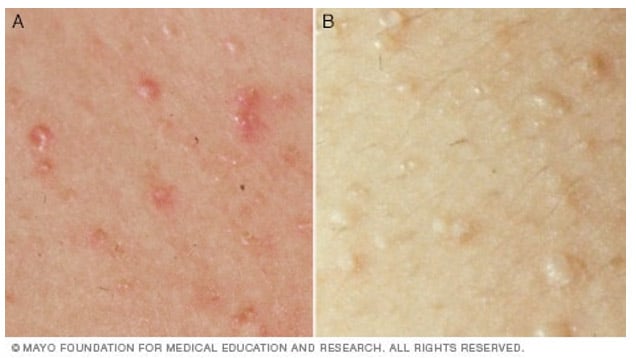How to Identify and Treat Summer Skin Rashes
Nothing ruins summer plans like itchy bumps and painful rashes – but they don’t have to! Learning how to identify a rash will help to know how to properly treat them and reduce discomfort quickly.
Before you start self-diagnosing it is important to remember while summer rashes usually clear up with an over-the-counter cream, rashes that include fever, headache, shortness of breath, or abdominal pain require an immediate trip to the doctor.
Dr. Kent Walker, board-certified dermatologist with Forefront Dermatology, shares the top summer rashes, what to look for when identifying these rashes, their possible causes and how to treat them:
Heat rash
 What to look for: Small zit-like bumps on the back and chest, or deep, painful, acne-like breakouts in more severe cases.
What to look for: Small zit-like bumps on the back and chest, or deep, painful, acne-like breakouts in more severe cases.
Cause and Prevention: Heat rash is caused by excessive sweating in hot, humid weather which lead to clogged pores and breakouts. If you know you are going to be sweating skip the heavy moisturizers, wear loose-fitting and/or moisture wicking clothing.
How to treat it: Use an anti-itch hydrocortisone cream to help relieve discomfort. The pores on the rash need to open up on their own for the rash to disappear. See a doctor if you are still itching after a week, or if the rash doesn’t go away on its own.
Poison ivy, oak, and sumac rash
What to look for: Tiny fluid-filled blisters in a linear or crisscross pattern.
Cause and Prevention: This rash is caused by direct contact with poison ivy, poison oak, or poison sumac. All three plants contain the toxin urushiol, which most people are allergic to. If you’ve been exposed before, you’ll likely notice the rash within 48 hours, but blisters can take up to 10 days to appear if it’s your first encounter. The best form of prevention is to be aware of your surroundings nad know what each of these leaves look like.
How to treat it: For mild cases, an anti-itch hydrocortisone cream should control itching. In more severe cases, use an antihistamine. See a doctor if itching is still present after a week, or if the rash lingers for a couple weeks.
Lyme disease rash
What to look for: A small, red bump that grows into a large, plastic-feeling bullseye after a few days.
Cause and Prevention: Lyme disease rash occurs when you are bitten by a tick that transfers the bacteria to you. You’ll notice the bite right away, and the disease can follow. The best prevention is wearing long pants and sleeves when in a wooded or tall grass area.
How to treat it: Once you notice a tick, or the rash, see your doctor immediately. You’ll likely need an antibiotic, which will kill the infection. Untreated Lyme disease can lead to serious complications in the heart and joints.
Chigger rash
What to look for: Tiny pink or flesh-colored bumps that itch—a lot.
Cause and Prevention: Chiggers, small mites that live in tall grass and can latch onto skin, bite and leave behind itchy welts. Chiggers tend to be most active during the early evening and nighttime hours, so use DEET-based insect repellent if you’re hitting up a backyard barbecue or going for an after-dinner hike.
How to treat it: OTC anti-itch creams and oral antihistamines usually ease symptoms and help bumps to subside in about a week. See a doc if: If a week goes by and your OTC regimen hasn’t stopped the itch.
Skin Struggles?
Whether you are suffering from acne, an unexplained rash or any other skin issue, the skin health experts at Forefront Dermatology are ready to help. To find the Forefront dermatologist nearest you, visit the locations page today.
*All photos are property of the Mayo Foundation for Medical Education and Research.
